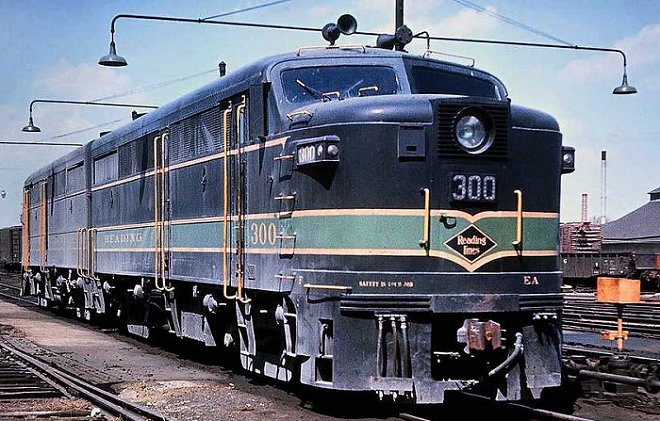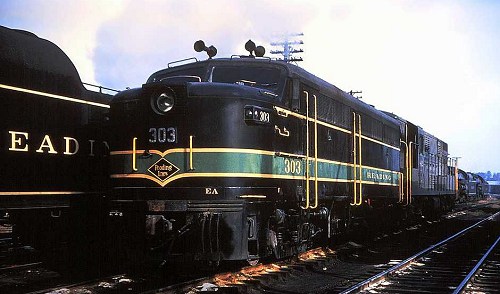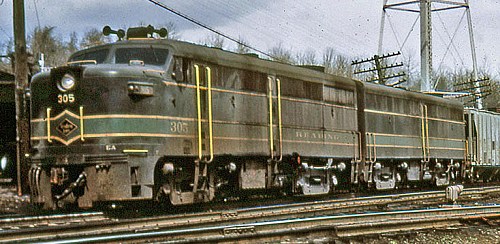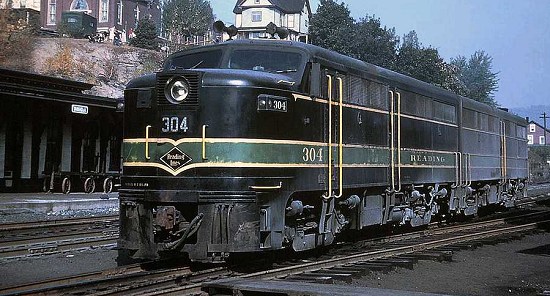Alco: FA-1/FB-1

The Reading's Alco FA-1/FB-1 locomotives arrived on the property in June, 1948. Designated class DF-3 and numbered 300A/B through 305A/B, and were delivered in the same black/green/yellow paint scheme as the Reading's EMD FT cab units. These locomotives were initially put into freight service between Newberry Junction and Tamaqua. While initially living up to the claims made by Alco in regard to hauling ability, these units soon began to experience a variety of mechanical problems, such as trouble with the cab doors, along with more significant issues such as crankshaft failure.
 The FAs were confined to the Shamokin Division during the first few years of their service. In 1949, #302A/B and #303A traveled to Reading to serve in pusher duty on the 1-mile Temple Hill grade heading eastbound out of Reading on the East Penn Branch. The following year, as more road diesels began to arrive on the property, the Alco FAs were seen in service in more locations on the southern portions of the system. The Alcos could not MU with EMD power, so they were most often run as A-B or A-B-A sets, or occasionally seen MU'd with an Alco RS-3. In 1956 as the units were overhauled, the MU systems were adjusted so that these units could operate with most other types of Reading road power.
The FAs were confined to the Shamokin Division during the first few years of their service. In 1949, #302A/B and #303A traveled to Reading to serve in pusher duty on the 1-mile Temple Hill grade heading eastbound out of Reading on the East Penn Branch. The following year, as more road diesels began to arrive on the property, the Alco FAs were seen in service in more locations on the southern portions of the system. The Alcos could not MU with EMD power, so they were most often run as A-B or A-B-A sets, or occasionally seen MU'd with an Alco RS-3. In 1956 as the units were overhauled, the MU systems were adjusted so that these units could operate with most other types of Reading road power.
 Reading Alco FA-1 #305A was severely damaged when it rear-ended train CaH-5 at Hershey in March, 1958. When it emerged from the Reading Locomotive Shops after heavy repairs, it received several new features, including a cab ventilator, additional handrails, and a slight modification to the green and yellow striping on the nose. As you can see from the photos above, on most Reading cab units, the point on the nose "dips" downward. On the rebuilt 305A, the upper yellow stripe pointed upward. This was the only Reading cab diesel to be so painted. As the 15-year equipment trusts expired in 1963, the Reading Alco FA1/FB1 locomotives were traded back to Alco for the purchase of the road's new 5200-series Century 424 locomotives.
Reading Alco FA-1 #305A was severely damaged when it rear-ended train CaH-5 at Hershey in March, 1958. When it emerged from the Reading Locomotive Shops after heavy repairs, it received several new features, including a cab ventilator, additional handrails, and a slight modification to the green and yellow striping on the nose. As you can see from the photos above, on most Reading cab units, the point on the nose "dips" downward. On the rebuilt 305A, the upper yellow stripe pointed upward. This was the only Reading cab diesel to be so painted. As the 15-year equipment trusts expired in 1963, the Reading Alco FA1/FB1 locomotives were traded back to Alco for the purchase of the road's new 5200-series Century 424 locomotives.
MODELING NOTES: The Alco FA-1/FB-1 locomotives would be most at home on a Shamokin Division layout set in the 1950s, though they were also used in mainline and crossline freight service during their careers. Take note of the placement of handrails along the carbody sides, and details such as the position of the air horns and the sand filler hatch on the locomotive nose. If you model #305A after 1958, be sure to decal the locomotive based on the modification described in the text and photo above. As these locomotives were off the system by April 1963, be mindful of mixing first and second-generation power on your layout, especially mixing Alco FA-1 and C424 locomotives, as the C424s actually rode on the trucks of the traded-in FA-1s!

Did You Know?
Downloads
 A variety of Reading Company operations related documents, etc. that may be of use in your modeling efforts.
A variety of Reading Company operations related documents, etc. that may be of use in your modeling efforts.
 A variety of Reading Company operations paperwork, such as train orders, clearance forms, etc. that will help you operate your Reading layout in a prototypical manner.
A variety of Reading Company operations paperwork, such as train orders, clearance forms, etc. that will help you operate your Reading layout in a prototypical manner.
 Public Timetables, Employe Timetables, and Rulebooks that provide much useful operational information.
Public Timetables, Employe Timetables, and Rulebooks that provide much useful operational information.
 Signs, billboards, and other FREE goodies for your use. We ask only that you help spread the word about The Reading Modeler!
Signs, billboards, and other FREE goodies for your use. We ask only that you help spread the word about The Reading Modeler!

